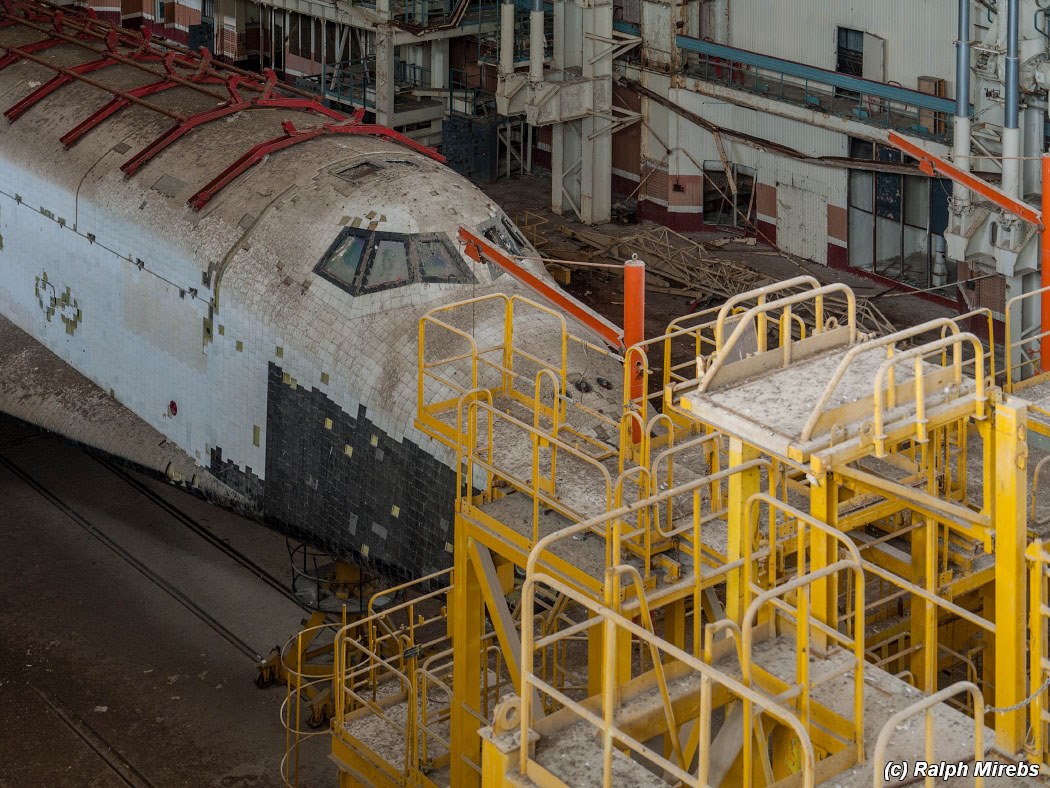Two abandoned Soviet shuttles
Baikonur Cosmodrome has just celebrated its 60s anniversary. Over these years many spacecraft tests have been conducted on its territory. The pinnacle of all these developments was the Energia-Buran system. Then history took a turn and the project died in infancy.
More than 20 years ago the heavy sliding doors of the hangar that served as an assembly and refueling complex were closed once and for all, cutting off the way to the alluring starry skies for two space shuttles.
There is a hint of irony in the fact that the birthplace of the shuttles that were destined to furrow through space eventually became their tomb.


This hangar is nearly the largest structure in the whole Baikonur Cosmodrome. Its length is 132 m (approx. 400 ft.) and the height is 62 m (approx. 200 ft.)


The framing of the hangar is made of reinforced steel and was supposed to endure the impact in case of a heavy carrier rocket explosion in the nearest launchpad.
A few four-story additions are adjacent to the sides of the main building that house various kinds of equipment needed to run tests, provide air ventilation and supply power.
Since all the manipulations with the shuttle had to be conducted in a dust-free environment, the space inside the hangar was maintained under pressure. All the doors leading to the hallways were hermetic.
There were 3 overhead crane tracks, each with a 400 tons carrying capacity. Above them there is an intricate network of roof-mounted footwalks that provided access to the lamps used to light the hangar.


Right now there are 2 spaceships inside the complex, one of them being the second operational shuttle named Burya, and the other an engineering mock-up.
The latter, in spite of being a mock-up, looks exactly like the real thing on the inside as well as on the outside. Both of them are not in their best condition, thus complementing each other to create a full impression of what the spacecraft was supposed to be like.


Now let’s descend a little to have a general view of the hangar.






There are dozens of various platforms equipped with hydraulic drives that are mounted on the side walls. They were able to move up and down as well as sideways so that working on the shuttles could be performed on all levels without touching the heat-protective tiles.
They also carried passenger stairways for getting on board.




Here I can’t refrain from showing you two historic photographs from Buran official website demonstrating the use of these platforms.



Now let’s go down to the orbiters. They are not mounted on chassis but on transporter trolleys that move around on rails built into the floors.




Both time and people have shown no mercy for the shuttles and their present state is is very poor. Part of the heat-reflecting tiles have fallen off, the windows of the cockpit are broken and the wings and bodies are covered by a thick layer of dust and bird faeces.




At the moment the works were stopped Burya was 95 per cent complete. The features that distinguish it from the mock-up are attitude engines installed in its front part as well as an individual pattern of the heat-reflecting tiles.







The tail of the spaceship has been deprived of the container with the brake parachutes, but the power plant looks generally intact.


The tail part of the mock-up is much better preserved, and the cockpit windows are intact as well.




Inside the mock-up everything looks just about the same as its “grown up” copy. Only a few elements are represented by wooden cubes with their weight and name indicated on them.
The hatch and the cockpit are a complete mess, but the engine and the payload sections are quite clean.










At the time of the struggle of the two political systems, the race of the two superpowers had a boosting effect on the scientific and technological progress.
Dozens of various projects were born with a possibility of military and ideological use. And though many of them never made it past the draft or mock-up stage, those that managed to pass the endless tests and committee reviews enjoyed unlimited government support.
Images by RALPH MIREBS, reproduced with permission






